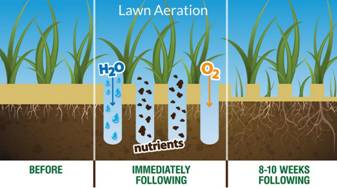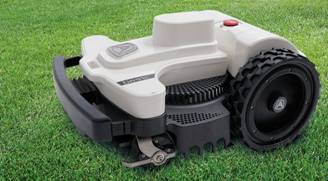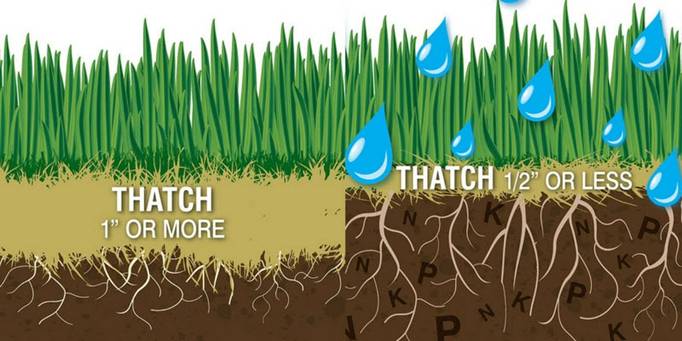|
Thatch is a layer of roots and dead grass stems that lays between the green, growing grass and the soil. A thin layer of thatch (less than 1/2 inch deep) is important for lawn health. A thin thatch layer protects the lawn from extreme heat or cold and provides cushioning to prevent soil compaction in high traffic areas. Too much thatch inhibits water absorption, making the lawn disease-prone. Soil compaction prevents oxygen and nitrogen from entering the soil. These gases promote root growth and contribute to the appropriate nutrient mix in the soil. Good soil is one of the most important factors for a healthy lawn so soil compaction prevention is definitely a good thing. When thatch becomes thicker than 1/2 inch, many problems can occur. Thatch acts like a sponge, soaking up moisture, but unfortunately, it dries out quickly. It holds few nutrients. Once thatch becomes too thick, the grass roots may start growing in it and never reach the soil. Since thatch has few nutrients, this is a recipe for a grass disaster. Thatch also creates grass stress in drought conditions. The thatch soaks up most of the water, the water evaporates and little water makes it to the soil. No water in the soil means the grass will not receive the soaking it needs to recover from a drought. Other thatch problems include harboring insects and harmful bacteria.
|
Lawn Thatch Prevention - Practical Ways to Avoid Thatch Problems |


|
Thatch Causes Thatch can be caused by multiple factors. First, be aware that certain grass types are prone to thatch and therefore may require more extreme prevention measures. These grass types include: Bermudagrass, St. Augustine grass, Zoysiagrass, Bluegrass and Red Fescue. In addition to grass type, excessive soil compaction causes thatch because the grass roots are unable to penetrate the soil. The roots grow and die on top of the soil, creating thatch. Another cause is infrequent mowing. Mulching lawn mowers chop up grass and leave grass clippings on the lawn. Normally these clippings are excellent fertilizer for the lawn. However, if mowing is not frequent enough, the clippings will be long and in large clumps. The clumps kill the grass underneath, creating thatch. Lastly, excessive fertilizer and watering can create too much grass growth. There may not be enough nutrients to support the excessive growth, so more grass stems will die and create thatch. Thatch Prevention There are a variety of things to do to prevent thatch. First, it is important to water and fertilize a proper amount, but not too much. One inch of rain/watering per week is a good rule of thumb. Follow the recommendations for the fertilizer you are using to prevent over fertilizing. Second, keep the soil pH above 5.5. pH less than 5.5 is too acidic for the grass to be healthy. Another important consideration is to mow often enough and to allow grass clippings to fertilize lawn. Mowing often is important since the clippings will be small to drop between grass stems and it will be possible to obey the one third rule of grass cutting. That is, to cut 1/3 the height of the grass off each time the grass is mowed. However, this should also consider the type of grass and their optimal mowing height. A common myth is that grass should always be mowed at 3 inches or higher. All common U.S. grasses except St. Augustine have an optimal mowing height under three inches. Some varieties of St. Augustine can be mowed as short as 2 1/2 inches. Some common grasses, such as Bermudagrass, Centipedegrass and Zoysiagrass should be mowed as low as one inch.
|


|
Thatch Removal Perhaps your thatch problem has already gone too far. The standard way to remove thatch is to aerate your lawn by using a tool that pokes 1-6 inch deep 3/4-inch wide holes into the soil. The soil/thatch plugs are removed by the tool and remain to decompose on the lawn. The nutrients from the air holes contribute to the decomposition of thatch. Another method is power raking. If your lawn's thatch is more than 1 1/2" thick, this is a poor situation. The lawn will need to be replaced using seed or sod. That is, rip it all up and start over.
|
|
Robot Mowers Prevent Thatch Avoid thatch altogether by using a preventative lawn mowing method. Robot mowers cut frequently, ensuring clippings are very small. The clippings fall into the lawn rather than lay on top of the grass. Unlike traditional mulching mowers, robot mowers’ clippings are invisible. Robot mowers are lightweight, often less than 30 lbs, so they will not compact the soil - one of the major causes of thatch. Robot mowers, such as Ambrogio Robot mower, obey the 1/3 rule of grass cutting and mow often enough to prevent thatch build-up.The roots grow much deeper due to frequent cutting, making the grass more drought tolerant. Less water and fertilizer are required because the roots can draw from lower layers of soil. Another bonus of a robot mower is that the homeowner has more spare time to aerate the lawn and perform other maintenance tasks. Lawns are much greener and healthier when mowed frequently by a robot mower. |
|
By: Kathy Moseler |